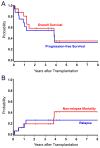Allogeneic haematopoietic cell transplantation after nonmyeloablative conditioning in patients with T-cell and natural killer-cell lymphomas
- PMID: 20507311
- PMCID: PMC2995443
- DOI: 10.1111/j.1365-2141.2010.08210.x
Allogeneic haematopoietic cell transplantation after nonmyeloablative conditioning in patients with T-cell and natural killer-cell lymphomas
Abstract
Patients with T-cell and natural killer-cell lymphomas have poor outcomes. This study examined the role of allogeneic haematopoietic cell transplantation (allo-HCT) after nonmyeloablative conditioning in this setting. Seventeen patients with T-cell lymphoma or NK-cell lymphoma, including three patients in first complete remission, received allo-HCT after 2 Gy total-body irradiation and fludarabine. The median age was 57 (range, 18-73) years. The median number of prior therapies was 3 (range, 1-7), six patients (35%) had failed prior autologous HCT, and five patients (29%) had refractory disease at the time of allograft. Postgrafting immunosuppression was provided with mycophenolate mofetil with ciclosporin or tacrolimus. After a median follow-up of 3.3 (range, 0.3-8.0) years among surviving patients, the estimated probabilities of 3-year overall and progression-free survival were 59% and 53%, respectively, while the estimated probabilities of non-relapse mortality and relapse at 3 years were 19% and 26%, respectively. Sixty-five percent of patients developed grades 2-4 acute graft-versus-host disease and 53% of patients developed chronic graft-versus-host disease. Allo-HCT after nonmyeloablative conditioning is a promising salvage option for selected patients with T-cell and NK-cell lymphomas. These results suggest that graft-versus-T-cell lymphoma activity is responsible for long-term disease control.
Conflict of interest statement
The authors have no conflicts of interest to disclose.
Figures

References
-
- Aksentijevich I, Jones RJ, Ambinder RF, Garrett-Mayer E, Flinn IW. Clinical outcome following autologous and allogeneic blood and marrow transplantation for relapsed diffuse large-cell non-Hodgkin’s lymphoma. Biology of Blood and Marrow Transplantation. 2006;12:965–972. - PubMed
-
- Armitage J, Vose J, Weisenburger D. International peripheral T-cell and natural killer/T-cell lymphoma study: pathology findings and clinical outcomes. Journal of Clinical Oncology. 2008;26:4124–4130. - PubMed
-
- Bernard M, Dauriac C, Drenou B, Leberre C, Branger B, Fauchet R, Le Prise PY, Lamy T. Long-term follow-up of allogeneic bone marrow transplantation in patients with poor prognosis non-Hodgkin’s lymphoma. Bone Marrow Transplantation. 1999;23:329–333. - PubMed
-
- Chan JK. Natural killer cell neoplasms (Review) Anatomic Pathology. 1998;3:77–145. - PubMed
-
- Charlson ME, Pompei P, Ales KL, MacKenzie CR. A new method of classifying prognostic comorbidity in longitudinal studies: development and validation. Journal of Chronic Diseases. 1987;40:373–383. - PubMed
Publication types
MeSH terms
Grants and funding
- CA18029/CA/NCI NIH HHS/United States
- CA92058/CA/NCI NIH HHS/United States
- K23 CA092058/CA/NCI NIH HHS/United States
- CA49605/CA/NCI NIH HHS/United States
- R00 HL088021/HL/NHLBI NIH HHS/United States
- CA15704/CA/NCI NIH HHS/United States
- P01 CA078902/CA/NCI NIH HHS/United States
- HL088021/HL/NHLBI NIH HHS/United States
- P01 CA018029/CA/NCI NIH HHS/United States
- P30 CA015704/CA/NCI NIH HHS/United States
- CA78902/CA/NCI NIH HHS/United States
- K99 HL088021/HL/NHLBI NIH HHS/United States
- P01 CA049605/CA/NCI NIH HHS/United States
LinkOut - more resources
Full Text Sources

